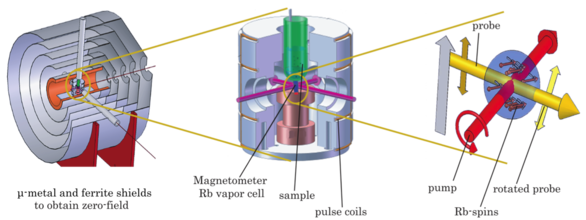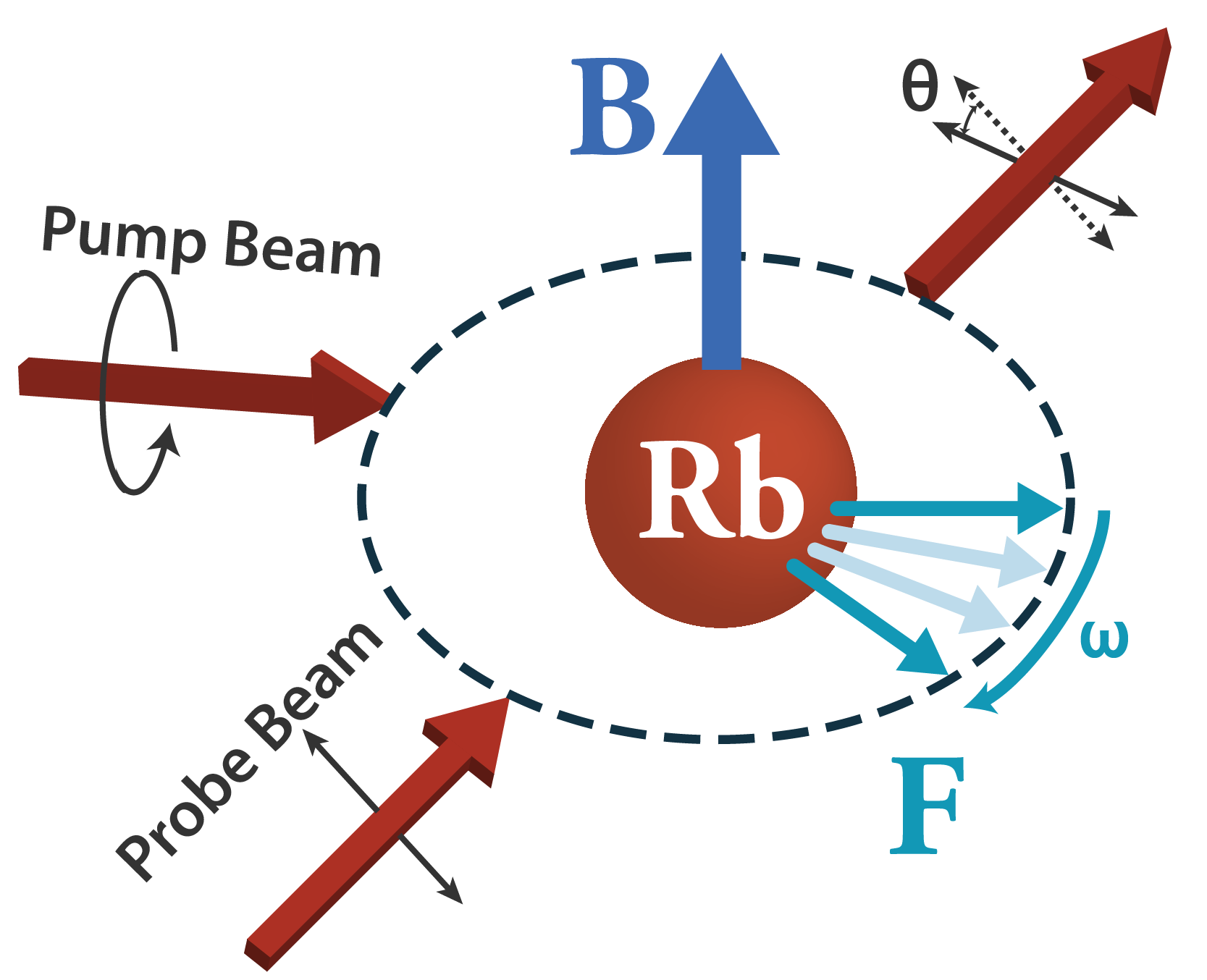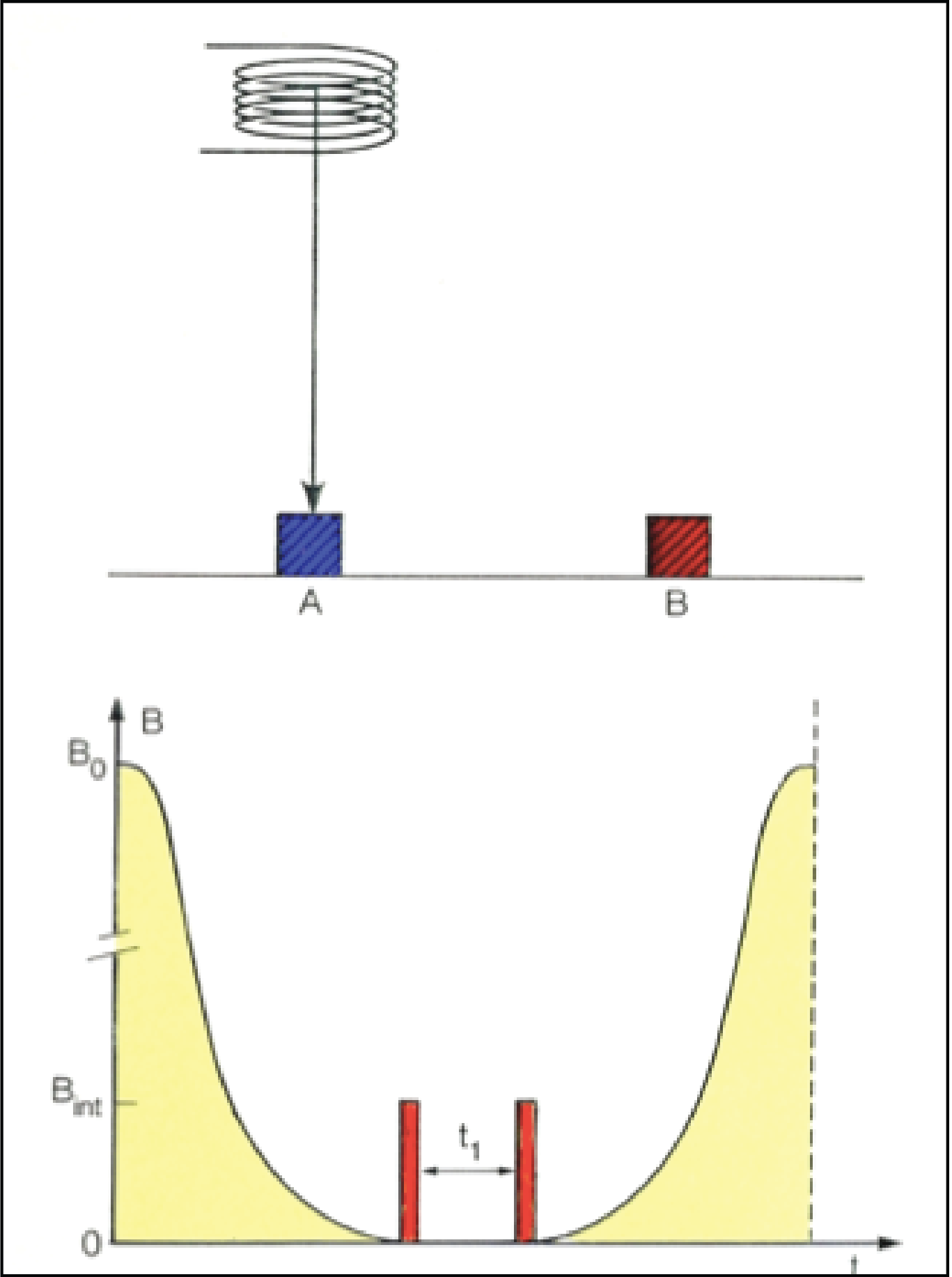
Overview
Nuclear magnetic resonance (NMR) is one of the most powerful analytical tools available to the chemical and biological sciences for chemical detection, characterization, and structure elucidation. However, the high magnetic fields required for conventional NMR require large, immobile, and expensive superconducting magnets, limiting the use of the technology. By performing NMR experiments at low or zero magnetic fields, the apparatus becomes significantly cheaper and more portable. Our zero-field instruments also feature extremely homogenous fields, which lead to narrow resonance lines, permitting the measurement of small couplings and the resolution of chemical species. As a result, these new techniques make NMR more analytically powerful and accessible to a wider audience. Our continuing research efforts are focused on understanding spectra, development of new experimental techniques for the study of chemical structure and dynamics, optimization of detection instrumentation, and signal enhancement for improved experimental efficiency.
Background
NMR is typically performed in large magnetic fields for three reasons: to improve chemical shift resolution, to maximize the sensitivity of detection by inductive coils, and to increase the magnitude of the measured signal by enhancing thermal polarization. However, these advantages come at a literal and figurative cost – modern superconducting magnets with sufficient homogeneity for NMR experiments can cost upwards of $1 million, are immobile, and must be maintained at cryogenic temperatures. As an alternative, by performing NMR experiments at zero-field, it is possible to retain many of the powerful analytical capabilities of high-field NMR, without the limitations imposed by the need for large magnetic fields.

In contrast with conventional NMR detection using inductive pickup coils that detect the time-derivative of the magnetic flux, thus leading to a sensitivity that is linearly dependent on the frequency of the detected signal, direct detection at zero- or ultra-low-field is achieved through the use of alkali vapor atomic magnetometers, which sense magnetic fields directly [1]. Such magnetometers operate by measuring the rotation of a linearly polarized probe laser due to its interaction with a spin-polarized volume, which is turn affected by the magnetic field of the sample [2]. These detectors do not require cryogenic temperatures, but in fact operate at or near room temperature, with demonstrated sensitivity approaching 100 aT/Hz1/2 at frequencies from zero to a few MHz [3]. We achieve a high signal-to-noise ratio in zero-field J-spectroscopy and relaxometry experiments using magnetometers based on microfabricated millimeter-scale vapor cells, which permits the use of 20-250 μL sample volumes, much smaller than typical samples for Earth’s field experiments [4].
Even at zero field, a great deal of spectral information remains and is well-resolved due to the absence of anisotropic broadening. In the absence of magnetic fields, the chemical shift vanishes, leaving isotropic fluid systems to evolve under the electron-mediated scalar coupling (J-coupling) as the primary interaction. Zero-field J-coupling spectra are very sensitive to molecular topology, bond and torsion angles [5], hybridization and bond order [6], molecular motion [7], and intermolecular interactions [8]. The addition of small perturbations from other spin interactions (for example, from small applied fields or anisotropic media) can yield additional information about the local state of an analyte by lifting degeneracies in the J-coupling energy levels [9]. The zero-field interactions thus incorporate sufficient specific chemical information to yield unique spectral fingerprints for different molecules and functional groups.
Sample polarization remains a challenge for zero-field NMR, because at thermal equilibrium in the absence of an applied magnetic field, polarization is zero. It is, however, possible to generate non-equilibrium polarization for zero-field experiments either by field-cycling [10] or by using one of a variety of so-called hyperpolarization techniques. We have demonstrated high signal-to-noise single-shot spectra using parahydrogen-induced polarization [11-12], and many other approaches (dynamic nuclear polarization, photochemically induced dynamic nuclear polarization, spin-exchange optical pumping, etc) are currently being investigated at zero field.
History
 Zero-field (or low-field) NMR has been a facet of NMR lore since the early days of the spectroscopy, for example the experiments conducted by Packard and Varian in 1954 to measure the Earth’s magnetic field by observing the precession of proton spins in a large sample of water [13]. In the 1980’s the Pines Lab began exploring zero-field NMR to measure solid samples via field-cycling techniques [14-21]. Despite needing to acquire point-by-point, early zero-field NMR was successfully used to measure structure [#], dynamics [#], and configuration [#] in solid powders, nematic and smectic liquid crystals [22-24], and isotropic liquids [20]. Research also lead to the development of “zero-field NMR at high-field” [25] which allowed for the recovery of information about local interactions which are usually overwhelmed by the interaction with the magnetic field.
Zero-field (or low-field) NMR has been a facet of NMR lore since the early days of the spectroscopy, for example the experiments conducted by Packard and Varian in 1954 to measure the Earth’s magnetic field by observing the precession of proton spins in a large sample of water [13]. In the 1980’s the Pines Lab began exploring zero-field NMR to measure solid samples via field-cycling techniques [14-21]. Despite needing to acquire point-by-point, early zero-field NMR was successfully used to measure structure [#], dynamics [#], and configuration [#] in solid powders, nematic and smectic liquid crystals [22-24], and isotropic liquids [20]. Research also lead to the development of “zero-field NMR at high-field” [25] which allowed for the recovery of information about local interactions which are usually overwhelmed by the interaction with the magnetic field.
With the introduction of non-inductive magnetic field detectors – first Superconducting QUantum Interference Devices (SQUIDs) [26,27], and now atomic magnetometers – the direct detection of NMR signals at zero field has become feasible [1, 4]. By shortening the experimental timescales associated with indirect detection and dramatically increasing spectral resolution, a new era of zero-field NMR research has emerged, building on previous successes to extend our understanding and explore new applications.
Current Directions
Our current efforts involve the development of optically detected zero-field NMR spectroscopy for applications in chemical analysis [10, 28], geology, and fundamental physics [29]. This includes the development of theoretical understanding of zero-field spectra [10, 30, 31], the implementation of hyperpolarization schemes [11,12], and the expansion of the information available at zero to ultra-low-field by the inclusion of symmetry-breaking fields and alignment media [9].
People Involved
Collaborators
Dmitry Budker (UC Berkeley, Mainz)
John Kitching (NIST)
References
[1] Budker, D.; Romalis, M. “Optical Magnetometry” Nature Physics, 3, 227–234. (2007)
[2] Seltzer, S. Ph.D. Thesis.
[3] I. M. Savukov, S. J. Seltzer, and M. V. Romalis, “Detection of NMR signals with a radio-frequency atomic magnetometer” Journal of Magnetic Resonance 185, 214 (2007).
[4] Ledbetter, M.P., Crawford, C.W., Pines, A., Wemmer, D.E., Knappe, S., Kitching, J., Budker, D. “Optical detection of NMR J-Spectra at Zero Magnetic Field” Journal of Magnetic Resonance, 199, 25-29 (2009).
[5] Karplus, M. “Contact Electron-Spin Coupling of Nuclear Magnetic Moments” Journal of Chemical Physics, 30(1), 11-15 (1959), and Karplus, M. “Vincinal Proton Coupling in Nuclear Magnetic Resonance” Journal of the American Chemical Society, 85(18), 2870-2871 (1963).
[6] Sutter, K.; Autschbach, J. Journal of the American Chemical Society, 134, 13374-13385 (2012)
[7] Pietrzak, M.; Benedict, C.; Gehring, H.; Daltrozzo, E.; Limbach, H.-H. J. Mol. Struct. 2007, 844-845, 222–231.
[8] Grzesiek, S.; Cordier, F.; Jaravine, V.; Barfield, M. Prog. Nucl. Mag. Res. Sp. 2004, 45, 275–300.
[9] Ledbetter, M.P., Theis, T., Blanchard, J.W., Ring, H., Ganssle, P., Appelt, S., Blu ̈mich, B., Pines, A., Budker, D. “Near-Zero-Field Nuclear Magnetic Resonance” Physical Review Letters, 107, 107601 (2011)
[10] Theis T, Blanchard JW, Butler MC, Ledbetter M.P, Budker D, Pines A. “Chemical analysis using J-coupling multiplets in zero-field NMR” Chemical Physics Letters, In Press.
[11] Theis T., Ganssle P., Kervern G., Knappe S., Kitching J., Ledbetter M.P, Budker D., Pines A. “Parahydrogen-enhanced zero-field nuclear magnetic resonance” Nature Physics, 7(7), 571-575 (2011).
[12] Theis T., Ledbetter M.P, Kervern G., Blanchard J.W, Ganssle P.J, Butler M.C, Shin H.D, Budker D., Pines A. “Zero-Field NMR Enhanced by Parahydrogen in Reversible Exchange” Journal of the American Chemical Society, 134(9), 3987-3990 (2012).
[13] M. Packard and R. Varian. “Free Nuclear Induction in the Earth’s Magnetic Field” Physical Review, 93, 941 (1954)
[14] Bielecki, A.; Zax, D. B.; Thayer, A. M.; Millar, J. M.; Pines, A. “Time Domain Zero Field NMR and NQR” Zeitschrift für Naturforschung, 41a, 440–444 (1986).
[15] Bielecki, A.; Zax, D. B.; Zilm, K. W.; Pines, A. “Time Domain Zero Field NMR and NQR” Review of Scientific Instruments, 57, 393–403 (1986).
[16] Millar, J. M.; Thayer, A. M.; Bielecki, A.; Zax, D. B.; Pines, A. “Zero Field NMR and NQR with Selective Pulses and Indirect Detection” Journal of Chemical Physics, 83, 934–938 (1985).
[17] Thayer, A. M.; Millar, J. M.; Pines, A. “Two-Dimensional Zero Field NMR” Chemical Physics Letters, 129, 55–58 (1986).
[18] Weitekamp, D. P.; Bielecki, A.; Zax, D.; Zilm, K.; Pines, A. “Zero-Field Nuclear Magnetic Resonance” Physical Review Letters, 50, 1807–1810 (1983). [Chemical & Engineering News v. 61, 23-24 (12 Dec 1983)]
[19] Zax, D. B.; Bielecki, A.; Kulzick, M. A.; Muetterties, E. L.; Pines, A. “Zero-Field NMR of Solid Bis(m-Hydrido) decacarbonyltriosmium” Journal of Physical Chemistry, 90, 1065–1069 (1986).
[20] Zax, D. B.; Bielecki, A.; Zilm, K. W.; Pines, A. “Heteronuclear Zero-Field NMR” Chemical Physics Letters, 106, 550–553 (1984).
[21] Zax, D. B.; Bielecki, A.; Zilm, K. W.; Pines, A.; Weitekamp, D. P. “Zero Field NMR and NQR” Journal of Chemical Physics, 83, 4877–4905 (1985).
[22] A.M. Thayer, J.M. Millar, M. Luzar, T.P. Jarvie, and A. Pines, “Zero Field NMR of a Nematic Liquid Crystal” Journal of Physical Chemistry, 90, 1577-1581 (1986)
[23] M. Luzar, A.M. Thayer, and A. Pines. “Zero Field NMR of Uniaxial and Biaxial Smectic Liquid Crystals” Molecular Physics, 62(3), 573-583 (1987).
[24] A.M. Thayer, M. Luzar, and A. Pines, “Zero-Field NMR Study of the Biaxial Smectic E Phase” Liquid Crystals, 2, 241-244 (1987).
[25] Tycko, R. “Zero-Field Nuclear Magnetic Resonance in High Field” Journal of Chemical Physics, 92, 5776-5793 (1990).
[26] McDermott, R.; Trabesinger, A. H.; Muck, M.; Hahn, E. L.; Pines, A.; Clarke, J. “Liquid-state NMR and scalar couplings in microtesla magnetic fields” Science, 295, 2247–2249 (2002.
[27] Trabesinger A.H., McDermott R., Lee, S.K., Mueck, M., Clarke, J., Pines, A. “SQUID-Detected Liquid State NMR in Microtesla Fields” Journal of Physical Chemistry A, 108, 957-963 (2004)
[28] Blanchard J.W, Ledbetter M.P, Theis T., Butler M.C, Budker D., Pines A. “High-Resolution Zero-Field NMR J-Spectroscopy of Aromatic Compounds” Journal of the American Chemical Society. 135(9), 3607-3612 (2013).
[29] Ledbetter M.P, Pustelny S., Budker D., Romalis M.V, Blanchard J.W, Pines A. “Liquid-State Nuclear Spin Comagnetometers” Physical Review Letters, 108(24), 243001 (2012).
[30] Butler MC, Ledbetter MP, Theis T, Blanchard JW, Budker D, Pines A. “Multiplets at zero magnetic field: The geometry of zero-field NMR” The Journal of Chemical Physics, 138(18), 184202-15 (2013).
[31] Butler MC, Kervern G, Theis T, Ledbetter MP, Ganssle PJ, Blanchard JW, Budker D, Pines A. “Parahydrogen-induced polarization at zero magnetic field” The Journal of Chemical Physics, 138(23), 234201 (2013)
